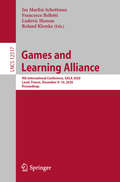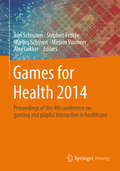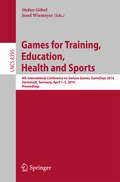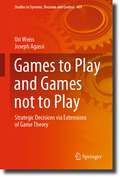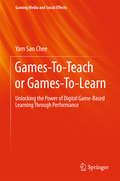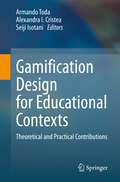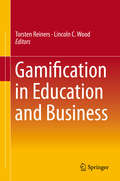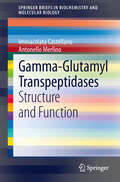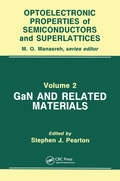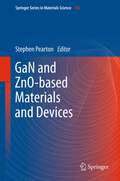- Table View
- List View
Games and Learning Alliance: Second International Conference, GALA 2013, Paris, France, October 23-25, 2013, Revised Selected Papers (Lecture Notes in Computer Science #8605)
by Alessandro De GloriaThis book constitutes the refereed proceedings of the Second International Conference on Games and Learning Alliance, GALA 2013, held in Paris, France, in October 2013.The 25 revised papers presented together with 9 poster papers were carefully reviewed and selected from numerous submissions. The papers advance the state of the art in the technologies and knowledge available to support development and deployment of serious games. They are organized in 3 research tracks on design, technology and application. Also included is the outcome of a GALA workshop on a widely applied instructional design model: 4C-ID.
Games and Learning Alliance: Third International Conference, GALA 2014, Bucharest, Romania, July 2-4, 2014, Revised Selected Papers (Lecture Notes in Computer Science #9221)
by Alessandro De GloriaThis book constitutes the refereed proceedings of the Third International Conference on Games and Learning Alliance, GALA 2014, held in Bucharest, Romania, in July 2014. The 15 revised papers presented were carefully reviewed and selected from 26 submissions. The papers presented cover a variety of aspects and knowledge fields. They are grouped into four sessions: pedagogy, technology, design, and applications.
Games and Learning Alliance: 4th International Conference, GALA 2015, Rome, Italy, December 9-11, 2015, Revised Selected Papers (Lecture Notes in Computer Science #9599)
by Alessandro De Gloria Remco VeltkampThis book constitutes the refereed proceedings of the 4th International Conference on Games and Learning Alliance, GALA 2015, held in Rome, Italy, in December 2015. The 33 revised full papers and 15 short papers presented were carefully reviewed and selected from 102 submissions. The papers presented cover a variety of aspects and knowledge fields. They are grouped around the following topics: games for health, games for mobility, pervasive gaming and urban mobility.
Games and Learning Alliance: 11th International Conference, GALA 2022, Tampere, Finland, November 30 – December 2, 2022, Proceedings (Lecture Notes in Computer Science #13647)
by Michael Kickmeier-Rust Francesco Bellotti Francesca De Rosa Kristian Kiili Koskinen Antti Muhterem DindarThis book constitutes the refereed proceedings of the 11th International Conference on Games and Learning Alliance, GALA 2022, held in Tampere, Finland, in November/December 2022. The 27 full papers and 9 short papers were carefully reviewed and selected from 61 submissions. The papers cover a broad spectrum of topics: Serious Games and Game Design; Serious Games for Instruction; Serious Game for Digital Literacy and Numeracy; Novel Approaches and Application Domains; Taxonomies and Evaluation Frameworks.
Games and Learning Alliance: 8th International Conference, GALA 2019, Athens, Greece, November 27–29, 2019, Proceedings (Lecture Notes in Computer Science #11899)
by Antonios Liapis Georgios N. Yannakakis Manuel Gentile Manuel NinausThis book constitutes the refereed proceedings of the 8th International Conference on Games and Learning Alliance, GALA 2019, held in Athens, Greece, in November 2019. The 38 regular papers presented together with 19 poster papers were carefully reviewed and selected from 76 submissions. The papers cover the following topics: serious game design and pedagogical foundations; AI and technology for SG; gamification; applications and case studies; and posters.The chapter "Cyber Chronix, Participatory Research Approach to Develop and Evaluate a Storytelling Game on Personal Data Protection Rights and Privacy Risks" is available open access under a CC BY 4.0 license at link.springer.com.
Games and Learning Alliance: 9th International Conference, GALA 2020, Laval, France, December 9–10, 2020, Proceedings (Lecture Notes in Computer Science #12517)
by Iza Marfisi-Schottman Francesco Bellotti Ludovic Hamon Roland KlemkeThis book constitutes the refereed proceedings of the 9th International Conference on Games and Learning Alliance, GALA 2020, held in Laval, France, in December 2020. The 35 full papers and 10 short papers were carefully reviewed and selected from 77 submissions. The papers cover a broad spectrum of topics: Serious Game Design; Serious Game Analytics; Virtual and Mixed Reality Applications; Gamification Theory; Gamification Applications; Serious Games for Instruction; and Serious Game Applications and Studies.
Games and Simulations in Teacher Education (Advances in Game-Based Learning)
by Elizabeth BradleyThis book includes more than twenty computer games and simulations for use in teacher training. Each of these simulations is innovative and presents an opportunity for pre-service teachers to have hands-on experience in an area of need prior to teaching in the classroom. Information on the simulation origins, including theoretical underpinnings, goals, characteristics, relevant research/program evaluation results, discussion of benefits and limitations as well as dissemination, recommended use, scope of practice, etc. of each game or simulation are included. Pre-service and new teachers will gain a number of useful skills through completion of these simulations and higher education faculty and administrators will gain a plethora of research-based and effective training tools for use in their teacher training programs.
Games for Health 2014: Proceedings of the 4th conference on gaming and playful interaction in healthcare
by Ben Schouten Stephen Fedtke Marlies Schijven Mirjam Vosmeer Alex GekkerFounded in 2004, the Games for Health Project supports community, knowledge and business development efforts to use cutting-edge games and game technologies to improve health and health care. The Games for Health Conference brings together researchers, medical professionals and game developers to share information about the impact of games, playful interaction and game technologies on health, health care and policy. Over two days, more than 400 attendees participate in over 60 sessions provided by an international array of 80+ speakers, cutting across a wide range of activities in health and health care. Topics include exergaming, physical therapy, disease management, health behavior change, biofeedback, rehab, epidemiology, training, cognitive health, nutrition and health education.
Games for Training, Education, Health and Sports: 4th International Conference on Serious Games, GameDays 2014, Darmstadt, Germany, April 1-5, 2014. Proceedings (Lecture Notes in Computer Science #8395)
by Stefan Göbel Josef WiemeyerThis book constitutes the refereed proceedings of the 4th International Conference on Serious Games for Training, Education, Health and Sports, Game Days 2014, held in Darmstadt, Germany, in April 2014. The 13 full papers presented together with 3 short papers, 2 keynotes, and 3 workshop papers were carefully reviewed and selected for inclusion in this book. The topics of the papers are settled in the fields of (game-based) training, teaching and learning, authoring tools, mobile gaming, health and rehabilitation, and citizen science. The papers address a broad scope of issues, including mechanisms and effects of (Serious) Games, adaptation and personalisation, local, mobile, and internet learning and education applications, game, reuse and evaluation, game settings, types of learners, problem solving etc.
Games: Purpose and Potential in Education
by Christopher Thomas MillerThe field of Games is rapidly expanding, prompting institutions throughout the world to create game development programs and courses focusing on educational games. As a result, games have also become a hot topic in the area of educational technology research. This increased interest is due to the technological advancement of digital games and the fact that a new, digital generation is emerging with a strong gaming background. Games: Purpose and Potential in Education focuses on the issues of incorporating games into education and instructional design. Ideas of identity development, gender diversity, motivation, and integrating instructional design within game development are addressed since each of these areas is important in the field of instructional design and can have a significant impact on learning. This volume brings together leading experts, researchers, and instructors in the field of gaming and explores current topics in gaming and simulations, available resources, and the future of the field.
Games to Play and Games not to Play: Strategic Decisions via Extensions of Game Theory (Studies in Systems, Decision and Control #469)
by Uri Weiss Joseph AgassiThis book contributes to the theoretical discussions of equilibria that rest on error―in which we include mistaken choices of games to play. Extant game theory recommends diverse strategies (plans of actions) for various given games, particularly those in Nash equilibria, in which no player benefits from one-sided strategy alteration. The literature also refers to the design of games that fit given goals. This is the mechanism design theory; its function is to serve social planners ignorant of the preferences of the people intended to play them.Our study of games avoidance adds to game theory the meta-game of choosing what game to play and what game to avoid playing, and that both players and planners can generate. This comprises a shift from the maximalist position that aims to maximize possible profit to the minimalist one that aims at minimizing possible loss. This shift depends on the question, considering the public interest, what set of games is it advisable to encourage? Obviously, it is advisable to encourage playing some groups of games such as trade, as well as to discourage playing other groups of games such as wars. This shift makes the theory much more applicable to social science: usually, choosing what game to play is less practical than choosing what game not to play. This invites legislation and similar incentives; their study should aim at the improvement of their usefulness.Discussing the possibility of changing both game and strategy renders game theory part-and-parcel of social science. For this mathematical models will not do: it requires a clear distinction between describing options and explaining situations. Explanations may enhance efforts at improvement.
Games-To-Teach or Games-To-Learn: Unlocking the Power of Digital Game-Based Learning Through Performance (Gaming Media and Social Effects)
by Yam San CheeThe book presents a critical evaluation of current approaches related to the use of digital games in education. The author identifies two competing paradigms: that of games-to-teach and games-to-learn. Arguing in favor of the latter, the author advances the case for approaching game-based learning through the theoretical lens of performance, rooted in play and dialog, to unlock the power of digital games for 21st century learning. Drawing upon the author’s research, three concrete exemplars of game-based learning curricula are described and discussed. The challenge of advancing game-based learning in education is addressed in the context of school reform. Finally, future prospects of and educational opportunities for game-based learning are articulated.Readers of the book will find the explication of performance theory applied to game-based learning especially interesting. This work constitutes the author’s original theorization. Readers will derive four main benefits: (1) an explication of the difference between game-based-teaching and game-based learning, and why this difference is of critical importance, (2) an exposition of the theory of game-based learning as performance, (3) concrete exemplars and research outcomes relating to three game-based learning curricula that have been empirically evaluated in schools, and (4) an understanding of complex issues related to the human side of school change that must be effectively addressed to achieve take-up of game-based learning in schools.
Gamification Design for Educational Contexts: Theoretical and Practical Contributions
by Armando Toda Alexandra I. Cristea Seiji IsotaniHave you ever wondered how to best add game-like elements to your (online) courses? What makes some game features desirable, and others boring? This book covers gamification design in educational domains. It is aimed at practitioners, researchers and academics alike. Gamification design is a recent and relevant topic in many domains; however, it is not well explored in the domain of education, with only a few frameworks available and most of these being only academic (e.g., theoretical) and not addressing practical issues related to education practitioners (e.g., teachers and instructors). The book is divided into 3 parts, in part 1 we explain some basic concepts related to gamification and gamification design, its importance for the education domain, possible negative effects if gamification design is neglected, and aspects that are still not encompassed by this field. Following, part 2 focus on explaining data-driven gamification design concepts as well as a research framework on how to use data mining algorithms to analyze and interpret data to generate strategies that can be used in education domain. It also presents a conceptual framework on how to apply those strategies in the education domain, focusing on the teacher and instructor; Finally, part 3 presents discussions regarding the concepts covered in the book, as well as possible research directions
Gamification in Education and Business
by Torsten Reiners Lincoln C. WoodThis book is dedicated to applied gamification in the areas of education and business, while also covering pitfalls to avoid and guidelines needed to successfully implement for a project. Using different theoretical backgrounds from various areas including behavioral economics, game theory, and complex adaptive systems, the contributors aim to help readers avoid common problems and difficulties that they could face with poor implementation. The book’s contributors are scholars and academics from the many areas where the key theory of gamification typically comes from. Ultimately, the book’s goal is to help bring together the theories from these different disciplines to the field of practice in education and business.The book is divided into four parts: Theory, Education, Business, and Use Cases. Part I provides a foundation on the theory of gamification and offers insight into some of the outstanding questions that have yet to be addressed. In Part II, the application and value that gamification can bring within the education sector is examined. The book then changes focus in Part III to spotlight the use of gamification within business environments. The topics also cover educational aspects like improved learning outcomes, motivation, and learning retention at the workplace. Finally Part IV concentrates on the applications and use of gamification through a series of case studies and key elements that are used in real situations to drive real results.
Gamification in Learning and Education: Enjoy Learning Like Gaming (Advances in Game-Based Learning)
by Sangkyun Kim Kibong Song Barbara Lockee John BurtonThis book explores the theoretical foundations of gamification in learning and education. It has become increasingly difficult to engage and motivate students. Gamification not only makes learning interesting, but also allows game players to solve problems and learn lessons through repeated attempts and failures. This "positive failure" can motivate students to attempt a difficult mission. Chapters in this volume cover topics such as the definition and characteristics of gamification, gamification in learning and education, theories, research on gamification, framework, strategy, and cases.
Gamish: A Graphic History of Gaming
by Edward RossA thrilling illustrated journey through the history of video games and what they really mean to usPac-Man. Mario. Minecraft. Doom.Ever since he first booted up his brother's dusty old Atari, comic artist Edward Ross has been hooked on video games. Years later, he began to wonder: what makes games so special? Why do we play? And how do games shape the world we live in?This lovingly illustrated book takes us through the history of video games, from the pioneering prototypes of the 1950s to the modern era of blockbuster hits and ingenious indie gems. Exploring the people and politics behind one of the world's most exciting art-forms, Gamish is a love letter to something that has always been more than just a game.
Gamma-Glutamyl Transpeptidases: Structure and Function (SpringerBriefs in Biochemistry and Molecular Biology)
by Immacolata Castellano Antonello MerlinoGamma-Glutamyl Transpeptidases (γ-GTs) are members of the N-terminal nucleophile hydrolase superfamily, enzymes that cleave the γ-glutamyl amide bond of glutathione to liberate cysteinylglycine. The released γ-glutamyl group can be transferred to water (hydrolysis) or to amino acids or short peptides (transpeptidation). γ-GT plays a key role in the gamma glutamyl cycle by regulating the cellular levels of the antioxidant glutathione, hence it is a critical enzyme in maintaining cellular redox homeostasis.γ-GT is upregulated during inflammation and in several human tumors, and it is involved in many physiological disorders related to oxidative stress, such as Parkinson’s disease and diabetes. Furthermore, this enzyme is used as a marker of liver disease and cancer. This book covers current knowledge about the structure-function relationship of γ-GTs and gives information about applications of γ-GTs in different fields ranging from clinical biochemistry to biotechnology and biomedicine.
Gamma Ray Imaging: Technology and Applications
by Junwei Du Krzysztof Kris IniewskiThis book will provide readers with a good overview of some of the most recent advances in the field of detector technology for gamma-ray imaging, especially as it pertains to new applications. There will be a good mixture of general chapters in both technology and applications in medical imaging and industrial testing. The book will have an in-depth review of the research topics from world-leading specialists in the field. The conversion of the gamma-ray signal into analog/digital value will be covered in some chapters. Some would also provide a review of CMOS chips for gamma-ray image sensors.
Gamma Titanium Aluminide Alloys: Science and Technology
by Fritz Appel Jonathan David Paul Michael OehringThe first book entirely dedicated to the topic emphasizes the relation between basic research and actual processing technologies. As such, it covers complex microstructures down to the nanometer scale, structure/property relationships and potential applications in key industries. From the contents: * Constitution * Thermophysical Constants * Phase Transformations and Microstructures * Deformation Behaviour * Strengthening Mechanisms * Creep * Fracture Behaviour * Fatigue * Oxidation Resistance and Related Issues * Alloy Design * Ingot Production and Component Casting * Powder Metallurgy * Wrought Processing * Joining * Surface Hardening * Applications and Component Assessment
Gamma Titanium Aluminide Alloys: Science and Technology
by Fritz Appel Jonathan David Paul Michael OehringThe first book entirely dedicated to the topic emphasizes the relation between basic research and actual processing technologies. As such, it covers complex microstructures down to the nanometer scale, structure/property relationships and potential applications in key industries. From the contents: * Constitution * Thermophysical Constants * Phase Transformations and Microstructures * Deformation Behaviour * Strengthening Mechanisms * Creep * Fracture Behaviour * Fatigue * Oxidation Resistance and Related Issues * Alloy Design * Ingot Production and Component Casting * Powder Metallurgy * Wrought Processing * Joining * Surface Hardening * Applications and Component Assessment
GaN and Related Materials
by 9789056995171Presents views on current developments in heat and mass transfer research related to the modern development of heat exchangers. Devotes special attention to the different modes of heat and mass transfer mechanisms in relation to the new development of heat exchangers design. Dedicates particular attention to the future needs and demands for further development in heat and mass transfer. GaN and related materials are attracting tremendous interest for their applications to high-density optical data storage, blue/green diode lasers and LEDs, high-temperature electronics for high-power microwave applications, electronics for aerospace and automobiles, and stable passivation films for semiconductors. In addition, there is great scientific interest in the nitrides, because they appear to form the first semiconductor system in which extended defects do not severely affect the optical properties of devices. This series provides a forum for the latest research in this rapidly-changing field, offering readers a basic understanding of new developments in recent research. Series volumes feature a balance between original theoretical and experimental research in basic physics, device physics, novel materials and quantum structures, processing, and systems.
GaN and Related Materials
by Stephen J. PeartonPresents views on current developments in heat and mass transfer research related to the modern development of heat exchangers. Devotes special attention to the different modes of heat and mass transfer mechanisms in relation to the new development of heat exchangers design. Dedicates particular attention to the future needs and demands for further development in heat and mass transfer. GaN and related materials are attracting tremendous interest for their applications to high-density optical data storage, blue/green diode lasers and LEDs, high-temperature electronics for high-power microwave applications, electronics for aerospace and automobiles, and stable passivation films for semiconductors. In addition, there is great scientific interest in the nitrides, because they appear to form the first semiconductor system in which extended defects do not severely affect the optical properties of devices. This series provides a forum for the latest research in this rapidly-changing field, offering readers a basic understanding of new developments in recent research. Series volumes feature a balance between original theoretical and experimental research in basic physics, device physics, novel materials and quantum structures, processing, and systems.
GaN and SiC Power Devices: From Fundamentals to Applied Design and Market Analysis (Synthesis Lectures on Engineering, Science, and Technology)
by Maurizio Di Paolo EmilioThis book provides a single-source reference for any reader requiring basic and advanced information on wide bandgap semiconductors and related design topics. Focusing on practicability, it explains the principles of GaN and SiC semiconductors, manufacturing, characterization, market and design for key applications.
GaN and ZnO-based Materials and Devices (Springer Series in Materials Science #156)
by Stephen PeartonThe AlInGaN and ZnO materials systems have proven to be one of the scientifically and technologically important areas of development over the past 15 years, with applications in UV/visible optoelectronics and in high-power/high-frequency microwave devices. The pace of advances in these areas has been remarkable and the wide band gap community relies on books like the one we are proposing to provide a review and summary of recent progress.
GaN-Based Laser Diodes: Towards Longer Wavelengths and Short Pulses (Springer Theses)
by Wolfgang G. ScheibenzuberThe emergence of highly efficient short-wavelength laser diodes based on the III-V compound semiconductor GaN has not only enabled high-density optical data storage, but is also expected to revolutionize display applications. Moreover, a variety of scientific applications in biophotonics, materials research and quantum optics can benefit from these versatile and cost-efficient laser light sources in the near-UV to green spectral range. This thesis describes the device physics of GaN-based laser diodes, together with recent efforts to achieve longer emission wavelengths and short-pulse emission. Experimental and theoretical approaches are employed to address the individual device properties and optimize the laser diodes toward the requirements of specific applications.





